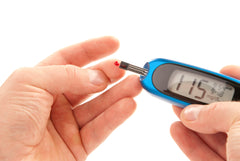Your Cart is Empty
1 YEAR WARRANTY ON ALL PRODUCTS - **Please Note No International Shipping Outside of the USA**
1 YEAR WARRANTY ON ALL PRODUCTS - **Please Note No International Shipping Outside of the USA**
Exercise is safe and is also highly recommended for most people with type 2 diabetes, including those with complications. Exercise, along with diet and medication will help you lower blood sugar and lose weight.
If you have not exercised for a long time, don't worry. It's fine to start slow and work your way up!
These helpful tips will help you ease back into exercise, and find a workout plan that works best for you!


As long as you're totaling 30 minutes of exercise daily, several brief workouts are fine, says George Griffing, MD, professor of endocrinology at the Saint Louis University School of Medicine in St. Louis.
"We need people with diabetes up and moving," Dr. Griffing says. "If you can do your exercise in one 30 minute stretch, fine. But if not, break it up into increments you can manage that add up to at least 30 minutes each day."

Increase activity in general, such as walking or climbing stairs, rather than a particular type of exercise.
However, don't rely on housework or other daily activity as your sole exercise. Too often, people overestimate the amount of exercise they get and underestimate the amount of calories they consume.
A step-counting pedometer can be very useful, which takes us to the next point...

In 2007 Stanford University researchers conducted a review of 26 studies looking at the use of pedometers as motivation for physical activity. The review found that people who used a pedometer increased their activity by 27%.
Pedometer users lost more weight, had a greater drop in blood pressure, and walked about 2,500 steps more per day than those who didn't use a pedometer.

Working our with friends can be an important motivator, especially for people over 60, according to Vicki Conn, PhD, the associate dean for research at the University of Missouri in Columbia, Mo., who has studied diabetes and exercise.
One way to do this, is to set up an 'exercise contract'. "One of the things we found with our meta-analysis is that behavioral strategies work better; that means setting up some sort of stimulus in the environment where you exercise," says Conn.

For example, you could set a goal of walking 10 minutes every Monday, Wednesday, and Saturday.
"That doesn't sound like a lot, but...setting up very specific goals like that helps people a lot more than telling people, 'Gee, you've got to exercise more,' " says Conn.

Instead of focusing on the bad things that could happen if you don't exercise, reward yourself for reaching each of your goals. You might say "OK, if I exercise 10 minutes, three times a week for the next three weeks, I'll call my sister-in-law who lives in Australia," says Conn.
Don't hold out for weight loss as an emotional "reward." Focus on other benefits, such as having more energy and being able to do the activities you love with your family and friends.

You can be creative with this one. You can try things like put a note on the refrigerator or keep your walking shoes next to the back door as a reminder to go for a walk and it'll be more likely to happen.

Write down your goals, remember be specific, and keep a record every time you do exercise, says Conn.
Visually show on your calendar every day whether you exercised for 10 or 15 minutes or more.

A class is good because there is an exercise leader and someone to call for emergency help, if necessary, says Conn.
"There is a structured experience exercising and they will learn how their body will react and then they will grow more confident to go out and exercise on their own," she says.

Working up to a moderate amount of exercise quickly isn't that important in terms of your long term health.
"What really matters is next year, you are doing it all the time," says Conn. "Getting there eventually in a way that you are able to stay with it is what is important because it is long-term behavior change that has health consequences."

You're more likely to be successful if you focus on changing one behavior at a time, rather than trying to change everything at once.
"What we found—and this is across many studies with thousands of people—if the study focuses only on changing one behavior, namely exercise, they get twice as much of an improvement in their hemoglobin A1C" says Conn.

Ask your doctor or diabetes educator to match you with a person who also has type 2 diabetes who has been successful at exercising and/or losing weight. They may have useful exercise or weight loss tips that work.

Make sure you keep up with your hemoglobin A1C and blood glucose testing. Good test results can encourage you to keep up with an exercise program, even when it feels tedious.
Be Sure to "Like" our Facebook Page to See All Our Happy Winners & Prizes